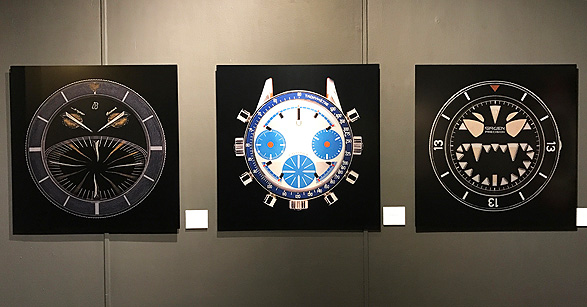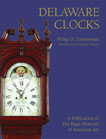Museum Exhibits

Special Exhibit - Watch Portraits by Atom Moore
April 30, 2017 through December 31, 2017
The National Watch & Clock Museum is honored to host an exhibit of the work of renowned photographer Atom Moore. In his collection, Watch Portraits, Atom explores the finest aspects of vintage and modern pieces. From his macro shots—incredibly beautiful photographs that peer into the subtle embellishments of each piece—to his whimsical "mashups" that extrapolate on those details through repetition and collage, Watch Portraits is a beautiful and unique look at the world of watches.
Special Exhibit - Art of Time
May 2017 through January 2018

“The Art of Time exhibit is a showcase of talented artists from around the world. The exhibition will feature original works and accompanying pieces from the museums expansive collection. From surrealist sculpture to paintings, there will be something for every artistic pallet.”

James Bond Wore the Quartz Revolution will challenge what visitors think they know. Displays feature important wristwatches from the commercial history as it unfolded—all worn by the James Bond character in the EON Productions movies of the period.
The exhibit opened June 3, 2015, at the National Watch & Clock Museum in Columbia, PA. Bond expert Dell Deaton (JamesBondWatches.com) curated the latest addition to expanded Museum displays to enhance the vital contributions of wristwatches to societies.
"We hope to correct myths arguing that the Quartz Revolution was nothing more than about making watches cheaper," says Deaton. "Or that an understanding of this 'revolution' requires no more than understanding how Quartz oscillators work as a time-basis. This exhibit seeks to explain why this revolution happened when it happened and shows how it continues to remain invaluable to contemporary society—at the very least, to reopen the discussion and move beyond cliché.
"The most important outcome of the Quartz Revolution was that it delivered a vast leap in one’s personal, mobile ability to control his own timekeeping. It was the culmination of a centuries-old pursuit, and it was delivered at exactly the period in history when consumers were ready for it and demanding it. None of this was simple or obvious as it was happening," Deaton continues. "The Quartz Revolution is essentially a consumer-driven story. That’s something too easily missed when you exclusively focus on the watch companies, betting on winners and losers who anted up for the battles as they played out in the 1970s, ’80s, and then finally settling down in the 1990s. By focusing on the fictional 'James Bond' character, we create a proxy for the consumer that can stand as a brand on equal footing with those of watchmakers. Thus, we can tell this story from its necessary, original perspective. I also think that makes it more globally objective as well."
At the center of this exhibit are examples of all 12 quartz James Bond wristwatches representing screen-correct models of those featured in EON productions movies premiered from 1973 through 1995.
It is believed that this is the first time ever that all real-world Bond quartz watches have been shown side-by-side and running. Moreover, these watches optimally reflect key challenges, solutions, and innovations of the Quartz Revolution in their own rights: They just happen to have been James Bond choices as well.
“We’re excited once again to explore an important aspect of wristwatch development through the story of James Bond,” says Museum Director Noel Poirier. “The Bond story is universally understood and relatable for our visitors and allows us to explore the significant influence of the quartz revolution in an engaging way.”
Access to the James Bond Wore the Quartz Revolution gallery is included with Museum admission.
The Library and Research Center has lending copies of many books available to NAWCC members.
Check availability in their Online Library Catalog or the Lending Library book list.
 Pillar & Scroll
Pillar & ScrollEli Terry revolutionized the Connecticut clockmaking industry in the nineteenth century with his ingenious mass production method and interchangeable parts. He did the impossible—fulfilled the Porter brothers’ contract to produce 4,000 clocks in three years. Terry built precision machine tools, which required gauges for measuring and jigs and fixtures to ensure repeatability. The woods used for the movements were all local: oak for the plates, cherry for the wheels, and laurelwood for the pinions. Peddlers who traveled to distant areas (e.g., southern United States) were the chief means of distributing the clocks. Seth Thomas, a joiner who put the clocks together, worked with Terry.
Terry experimented with several movement models. Many clockmakers imitated Terry’s pillar and scroll style. Women and girls participated in this cottage industry by painting clock dials and reverse painting clock tablets. These were some of the most beautiful timepieces ever created.
By 1838 the introduction of Jeromes’ inexpensive 30-hour brass movement marked the end of the wooden shelf clock business in Connecticut.

Thirty timepieces, dated from 1741 to 1815—the Golden Age of American and Delaware clocks—are featured in Delaware Clocks. Most of the clocks are tallcase, but near the end of the Golden Age table or bracket clocks appeared. This trend also was happening in New England as smaller and less expensive clocks were in demand, and tall clocks were phased out because of their greater expense and difficulty in transporting them by peddlers to far distant places.
The style of imported British and European clocks was copied, but regional differences did develop among the communities of artisans who made these clocks. Square brass dials were common features in the early clocks made in Delaware. The relative standardization of clockworks and dial sizes meant that cases were pretty much the same size and interchangeable.
William Furniss; George Crow; Thomas Crow; the Odessa, DE, clockmakers Benjamin Chandlee and Christopher Weaver and the casemaker John Janvier Sr.; Duncan Beard; and James and Daniel McDowell are some of the clock and casemakers featured in Delaware Clocks.
J. Carter Harris, Pennsylvania Clocks 1750-1850Harris characterizes the English, German, Swiss, and Scotch-Irish influences on clockmaking in Pennsylvania. He described the makers and included photographs of tall clocks from the counties of Philadelphia, Bucks, Chester, Berks, Lancaster, York, Dauphin, and Allegheny; bracket clocks from Philadelphia and Dauphin counties; shelf clocks from Montgomery, Lehigh, Lancaster, Dauphin, Snyder, Centre, and Allegheny counties; and a dwarf tall clock from Montgomery County.
Carter describes the differences, and Ed LaFond’s drawing clearly shows the English-style and German-style movements. Pennsylvania clockmaking in the eighteenth century was profoundly changed by the immigration of craftsmen from Germany; however, in the nineteenth century, with the cheap 30-hour brass movement shelf clocks by Chauncey and Noble Jerome, the era of handcrafted clocks came to an end.

Military timepieces often were designed like civilian timepieces, but they had to be specially constructed to do specific jobs. Luminous numerals or hands were needed for use at night. On aircraft vibration-free movements and cases were needed to keep timepieces running and accurate. Waterproof watches had to be designed for underwater operations. The timepieces had to be extremely accurate to coordinate timing for missions despite high or low temperatures or stale air on ships or mud in fox holes or trenches. Unbreakable crystals and non-glare dials also were very helpful.
Bricker recounts the evolution of military timepieces as he talks about the first use of the wristwatch in the Spanish-American War in 1898; Lieutenant Theodore Gordon Ellyson, the first naval aviator in World War I; the navigation instruments used by Richard E. Byrd in his flights to the North Pole and the South Pole; the Lindbergh Aviator Watch, designed and worn by Charles A. Lindbergh; Britain’s combination land plane, carrier plane, and seaplane used in World War II; and the chronograph, an aviator’s most valuable instrument that was used to measure time intervals between the firing and the explosion of the shell.










